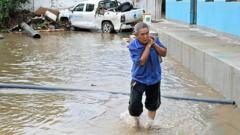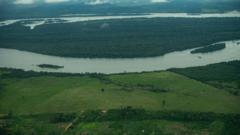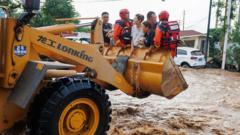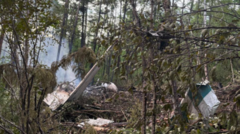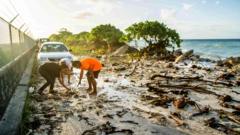Health officials have reported over 1,000 cases of respiratory illness resulting from a sandstorm sweeping across Iraq's central and southern regions. The latest figures reveal that nearly 700 individuals in Muthanna province suffered from acute suffocation, prompting urgent health responses. The storm enveloped the affected areas in a thick orange haze, leading to power outages and flight cancellations.
Iraq Faces Health Crisis as Sandstorm Triggers Respiratory Issues
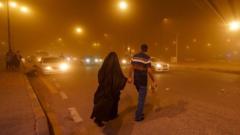
Iraq Faces Health Crisis as Sandstorm Triggers Respiratory Issues
A recent sandstorm in Iraq has left thousands grappling with severe breathing problems amid ongoing climate concerns.
Dust storms have been a persistent challenge for Iraq, but experts suggest that the frequency of these events is escalating due to climate change impacts. The environment ministry has cautioned that the nation is likely to experience an increase in “dust days.” Local authorities have taken precautions, with pedestrians and police donning face masks while paramedics were deployed to assist those with respiratory difficulties.
Reports indicate that hospitals were inundated with cases: over 250 in Najaf province and 322 in Diwaniyah province, with additional reports of breathing issues from Dhi Qar and Basra provinces as well. Visibility in southern Iraq dipped below one kilometer, forcing the shutdown of airports, particularly in Najaf and Basra. Although the conditions are projected to improve by Tuesday morning, the UN has classified Iraq among the top five nations most susceptible to the effects of climate change, which include frequent sandstorms and increasing heat waves.
This sandstorm follows a severe weather event in 2022 that resulted in the death of one person and left thousands needing medical attention for respiratory conditions. With climate patterns shifting, the environment ministry warns that these dust storms will only become more frequent.
As a result, Iraq stands at a critical juncture, where effective health and environmental strategies will be essential in combating the increasing threat posed by climate change.
Reports indicate that hospitals were inundated with cases: over 250 in Najaf province and 322 in Diwaniyah province, with additional reports of breathing issues from Dhi Qar and Basra provinces as well. Visibility in southern Iraq dipped below one kilometer, forcing the shutdown of airports, particularly in Najaf and Basra. Although the conditions are projected to improve by Tuesday morning, the UN has classified Iraq among the top five nations most susceptible to the effects of climate change, which include frequent sandstorms and increasing heat waves.
This sandstorm follows a severe weather event in 2022 that resulted in the death of one person and left thousands needing medical attention for respiratory conditions. With climate patterns shifting, the environment ministry warns that these dust storms will only become more frequent.
As a result, Iraq stands at a critical juncture, where effective health and environmental strategies will be essential in combating the increasing threat posed by climate change.


